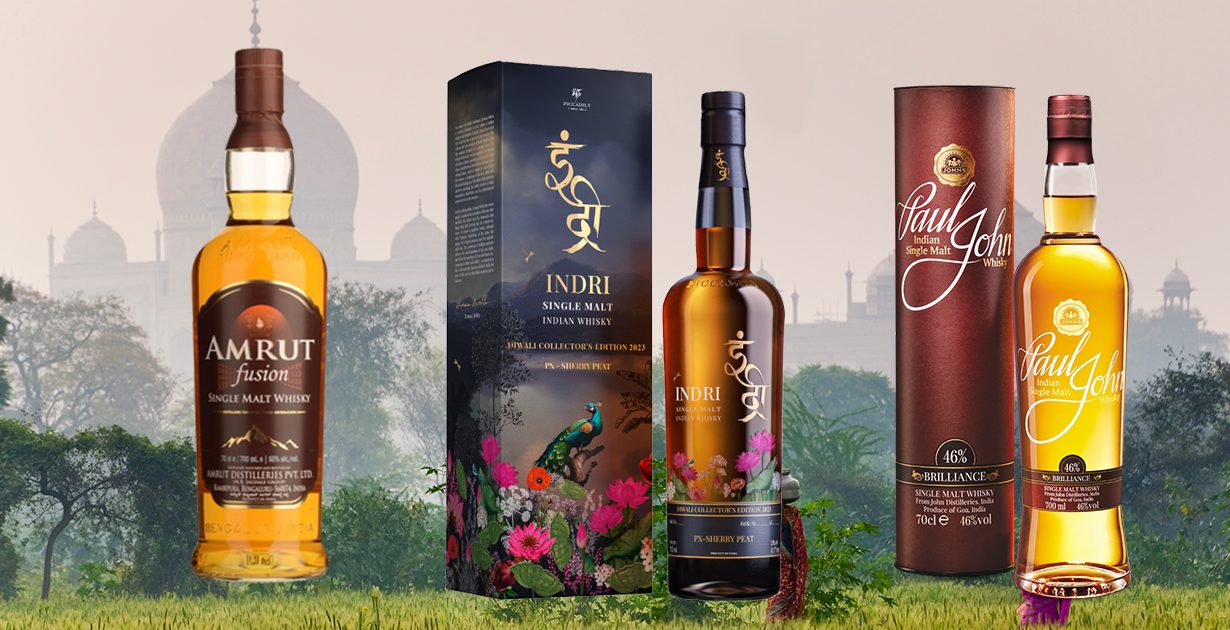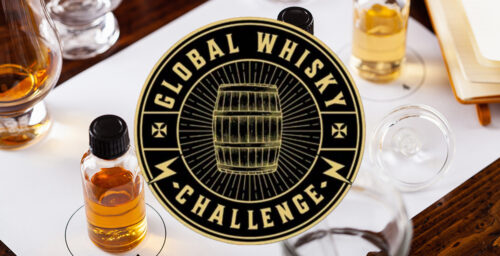
Since Amrut launched the first Indian single malt whisky in 2004, India has become established as one of the global whisky industry’s major producers, while a range of multi-award-winning malt whiskies have secured India’s reputation for quality spirits.
India’s tropical climate produces diverse and uniquely characterised malts, so let’s take a closer look at the origins, production, flavours and biggest brands. Here is everything you need to know about Indian whisky.
Everything You Need To Know About Indian Whisky’s Origins
Whisky distillation began in India during the 19th Century, as a result of British colonisation. Scotch whisky was initially imported in large quantities, to meet the demand of British soldiers and officials stationed in India.
In the late 1820s, Edward Abraham Dyer emigrated to India establishing the Kasauli Brewery and Solan distillery in the Solan district of Himachal Pradesh state of India. Importing distilling equipment from Scotland, Dyer identified a business opportunity, meeting the demand for whisky with locally-produced spirits.
Dyer selected the Solan district deep in the Himalayas due to the presence of abundant fresh spring water, whilst the climate at Solan’s altitude was reminiscent of Scotland’s climate, leading Dyer to state his ambition was “to produce a malt whisky as fine as Scotch whisky”.
In 1835, Dyer’s brewery operations were transferred to the Solan site, as an expanding population around Kasauli resulted in a shortage of spring water for beer production.
The Kasauli brewery was converted fully for whisky production in 1835, and since beginning distillation the Kasauli distillery has continuously produced a version of Solan No. 1, India’s first single malt whisky, and the only malt whisky distilled in the Himalayas.
The oldest distillery in India, and the Asian continent, the Kasauli distillery continues to distil whisky using the original copper pot still imported from Scotland in the 1820’s, and production methods established by Edward Abraham Dyer.
The Kasauli distillery uses malted barley, grown in the northern regions of India and local to the distillery, to produce Solan No. 1 whisky, which is matured in oak barrels for an undisclosed period of time.
Allegedly, the current owner Mohan Meakin Breweries steadfastly resists the use of any form of advertising for Solan No. 1 whisky, instead relying on word-of-mouth recommendations to promote sales.
The Production Process

One of the most important things you need to know about Indian whisky is how it is made. Indian whisky is produced using much the same process as scotch whisky; copper pot stills are used for distillation and the spirit is matured in oak casks. Despite this, there are some notable differences regarding ingredients and maturation which are unique to India’s whisky production process.
The majority of India’s distilled spirits labelled and sold in the domestic market as ‘whisky’ are closer in consistency to rum due to being distilled from molasses, falling within a category of alcohol termed as Indian-made foreign liquor (IMFL).
India’s IMFL brands, which predominantly blend sweet molasses-based spirit with flavourings or spices, cannot be marketed in the UK or EU which require products labelled as ‘whisky’ to be distilled from cereal grains.
In India, IMFL whisky brands account for approximately 60% of the domestic market, with widespread popularity amongst Indian consumers due to a combination of accessibility and affordability, whilst Scotch whisky imports are subject to India’s high import taxes and complex state excise laws.
Historically, India’s malt and grain whisky distillation occurred only on a small scale, as the production of alcohol from barley and cereal grain proved controversial in an era of widespread poverty and grain shortages.
India’s malt and grain spirit output was traditionally integrated into IMFL blends; speculation exists whether the historic Solan No. 1 whisky blends malt whisky with sugarcane spirit. Whilst Indian single malt distillers, John Distilleries and Radico Khaitan Ltd domestically released IMFL whisky brands ‘Original Choice’ and ‘8PM’.
India’s malt whisky distillers use indigenous six-row barley, grown in northern states including Haryana, Punjab, and Rajasthan for distillation. This contrasts with the majority of whisky producers around the globe, who more commonly use two-row barley varieties for distilling malt, although Indian distillers prefer six-row barley believing it imparts a spicier flavour profile.
Peated Indian whisky bottlings, including Amrut Fusion and Paul John Bold, are an exception using imported pre-peated Scottish barley for distillation.
Due to India’s hot tropical climate, the maturation period for Indian whiskies is much shorter than Scottish malts; to meet legal requirements for sale in the UK and EU malt whisky must be aged for at least three years, although Indian single malts are rarely released with higher age statements, and are typically matured for between four-five years.
Amrut’s master blender, Surinder Kumar, estimates one year of maturation in India, is the equivalent of three years in Scotland. India’s hot climate, also results in a larger ‘Angels Share’, the liquid lost to evaporation during the maturation process, estimated to be between 10-12% annually in India, compared with approximately 2% annual evaporation for Scottish malts.
Indian Whisky: Flavour Profile
Indian malt whiskies tend to possess a fruity and sweet flavour profile. Before Amrut’s UK single malt launch in 2004, the company conducted a series of blind tastings with a majority of tasters comparing Amrut’s whisky profile to Scotland’s Speyside region malts, recording sweet notes of vanilla and caramel.
In contrast to Scottish whiskies, Indian malts emphasise tropical fruit notes, including banana, pineapple, and mango; with the Paul John distillery uses copper pot stills featuring distinctive long necks to produce a fruitier spirit.
As India’s tropical climate results in a shorter cask maturation, the body of Indian whiskies is typically lighter and fresher, although the Rampur distillery situated in the foothills of the Himalayas proves an exception due to polar opposite climate conditions throughout the year; cold winters and Indian summers combine to give Rampur’s malt a richer depth and full-bodied dimension.
Everything You Need To Know About Indian Whisky’s Biggest Brands

Amrut Distilleries is a pioneer of Indian whisky, releasing India’s first single malt bottling in 2004. Amrut was originally founded as Amrut Laboratories in Bangalore, Karnataka in 1947, although only ventured into malt whisky distillation in 1982.
On the 24th August 2004, Amrut Single Malt became the first Indian single malt whisky released in the UK, whilst the Amrut Fusion expression released in 2009, was voted as the 3rd Best Whisky in the World in 2010 by Jim Murray, scoring the malt 97 points in his Whisky Bible.
John Distilleries was founded by Paul P. John in 1996, and began distilling malt whisky at the company’s Goa distillery in 2008. In May 2013, the Paul John single malt Indian whisky core range was launched for the international market, a trio of Paul John bottlings named ‘Brilliance’, ‘Edited’, and ‘Bold’, with the range including unpeated and peated expressions.
The Paul John distillery has subsequently experimented with cask finishes including Oloroso and PX sherry, while limited-edition releases include the annual Paul John Christmas Edition, first released in 2018.
Located in the foothills of the Himalayas, the Rampur Distillery & Chemical Company Ltd was established at Rampur, Uttar Pradesh in 1943. Owned by Radico Khaitan Ltd since 1972, the first Rampur Single Malt Indian Whisky was launched in 2016.
The Piccadily Distilleries Group was originally established as Kedar Nath and Sons, by K.N. Sharma in 1953, beginning as a liquor distributor in the Punjab region. In 1993, the Piccadily Group expanded into alcohol manufacturing and distilling, building one of India’s largest malt plants at the Indri distillery in 2010.
Piccadily Distilleries’, first bottling, the Indri Trini expression was launched internationally in 2021. The limited-edition Indri Diwali Collectors Edition 2023, a peated Indian single malt matured in PX sherry casks, was awarded ‘Best in Show Double Gold’ at the Whiskies of the World Awards 2023.







